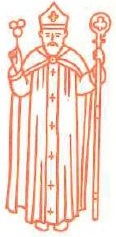 IRISH imagination has provided us with a rich assortment of legends about Saint Patrick. The best source, however, is Patrick himself who, in his old age, wrote a Confession which tells us most of what we know with certainty about the saint.
IRISH imagination has provided us with a rich assortment of legends about Saint Patrick. The best source, however, is Patrick himself who, in his old age, wrote a Confession which tells us most of what we know with certainty about the saint.
Saint Patrick was not an Irishman. He was born about 385 and, although the exact place of the event is not known, modern scholarship has determined southwest Britain as the most likely spot. Patrick writes that his parents were Christians but that he grew up in ignorance of the ”true God.” This probably means that Patrick was never seriously concerned with his faith and enjoyed a carefree boyhood. Patrick’s carefree days ended, however, when a roving band of Irish pirates raided his village and carried him back to Ireland as a slave.
For the next six years, Patrick tended sheep on the Irish hillsides and in the solitude of the work found his way to God. In his Confession he says that he prayed many times a day and that “the love of God and His fear came to me more and more, and my faith was strengthened.” He stayed “in the woods and on the mountain” and ”used to get up for prayer before daylight, through snow, through frost, through rain.” His renewal of faith was climaxed by a dream in which he was told to leave his master and walk to a distant place where he would find a ship to carry him from Ireland. After a journey of over two hundred miles, Patrick found the ship, set sail for his native land, and was soon reunited with his family.
The reunion was a brief one, however, for Patrick soon left home again. He had another dream in which he received letters from Ireland. On opening them, he saw the words “The voice of the Irish” and heard a thrilling sound–the collective voice of that pagan land, crying out to him, “We ask thee, boy, come and walk among us once more.” This dream meant one thing to Patrick: Ireland was asking for the faith and God was asking him to carry it there. And so he left home, preparing for his mission by studying in France for the priesthood. After his ordination and after formal approval for his mission had been given (probably by Pope Celestine I), Patrick was consecrated bishop, given a small band of monks as assistants, and about the year 43 2 was off to Ireland once more.
On his return to t he island, Patrick’s immediate concern was the conversion of the kings and druids (pagan priests), because he realized that only by converting them could he reach the mass of the people. In a series of dramatic encounters, the saint and his monks came before the kings of Ireland, defied the powers of the druids, and preached Christianity to the people. Tradition tells us that the most decisive of these meetings took place at Tara, the seat of King Leoghaire, where Patrick and his small band of Christians defied a pagan festival by celebrating their own Easter liturgy. The pagans, who hurriedly came to investigate, stayed to listen to the preaching of Patrick. Many were converted and from that time paganism was on the wane in Ireland.
In spite of this initial victory, an immense and perilous task remained to be done. In Patrick’s day Ireland was a wild and barbarous place. “How I would have loved to go to my country and my parents!” is the comment he makes in his Confession on his own feelings at this time. He writes that he never had any reason “except the gospel and its promises” for returning to Ireland, after having once escaped from it. Traveling ceaselessly up and down the island, Patrick preached Christianity until all had heard the message. By the time of his death in 461, Patrick had completed, almost single handedly, the conversion of the nation .
This was a staggering accomplishment and, as the Confession reveals, was carried out by a profoundly serious, often stern man who mixed humility and love with his zeal. The Irish people loved him who was so eager for their welfare, the man who humbly reminded them at the end of his life that, “With the grace of the Lord, I did everything lovingly and gladly for your salvation.” Patrick’s efforts were repaid, for within a few generations of the saint’s death, this small dot of land was known throughout Europe for the intensity of its religious life and, ever since, the Irish have clung to that religion in spite of suffering and difficulty.
Information from The Lives of Saints for every day of the year The Catholic Press, Inc. 1959. 157-159. © 1959 Reverend John P. O’Connell, STD NIHIL OBSTAT; IMPRIMATUR Samuel Cardinal Stritch, Archbishop of Chicago May 5 1958. Print.
Churches are:
Billings, Montana – Saint Patrick’s Co-Cathedral
Butte, Montana – Saint Patrick’s Catholic Church